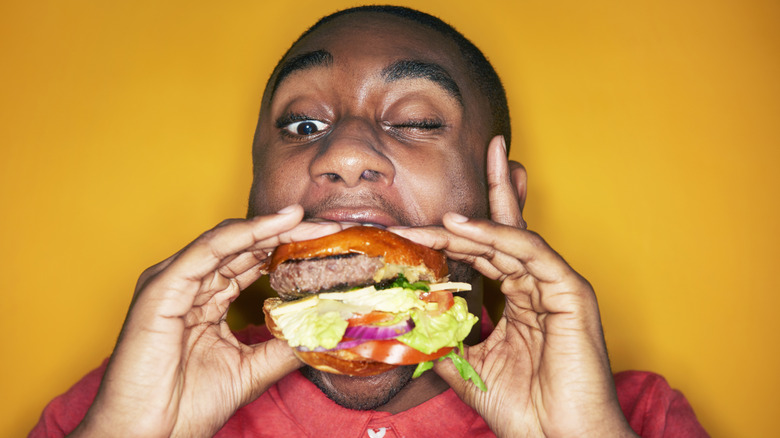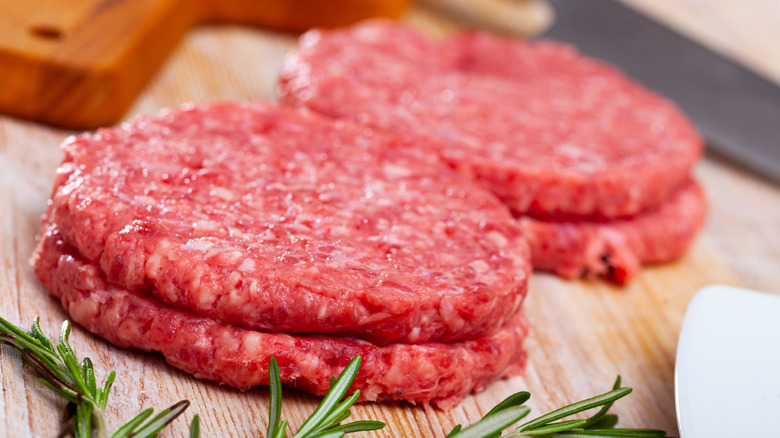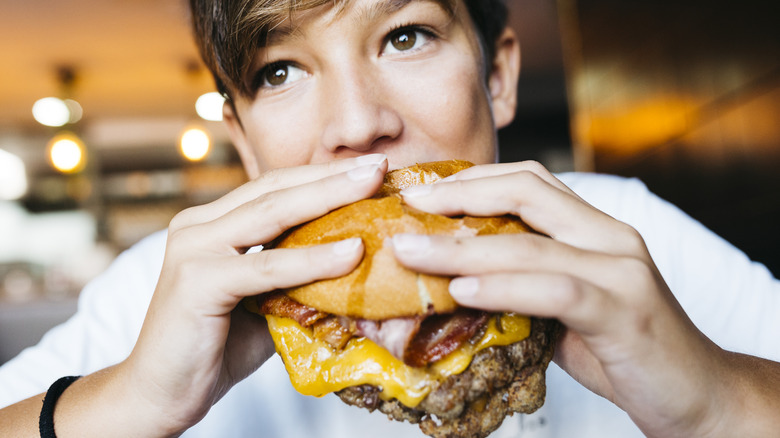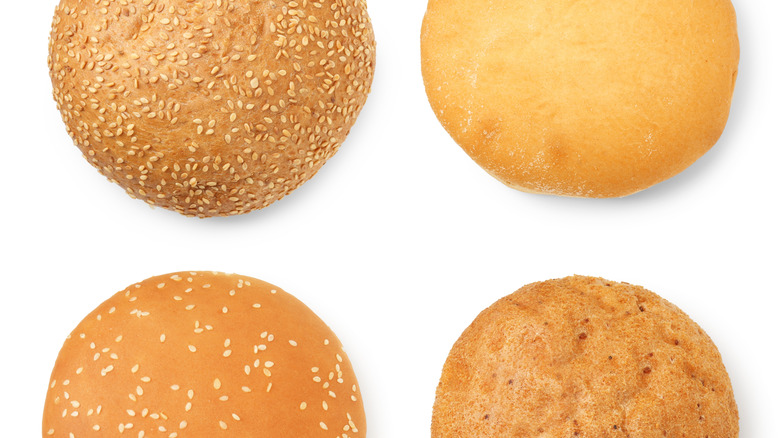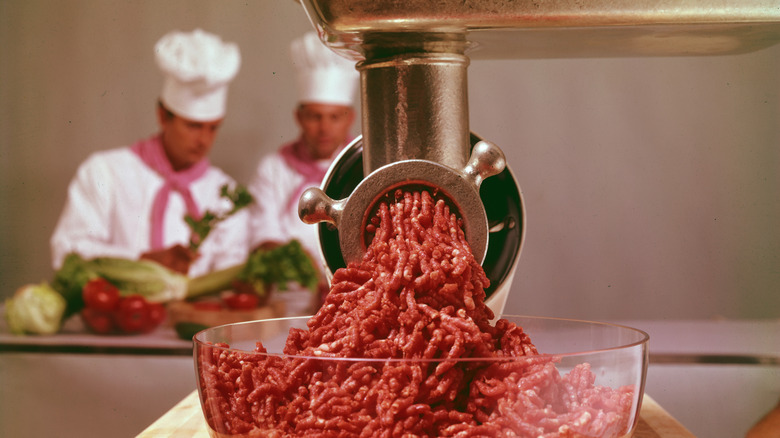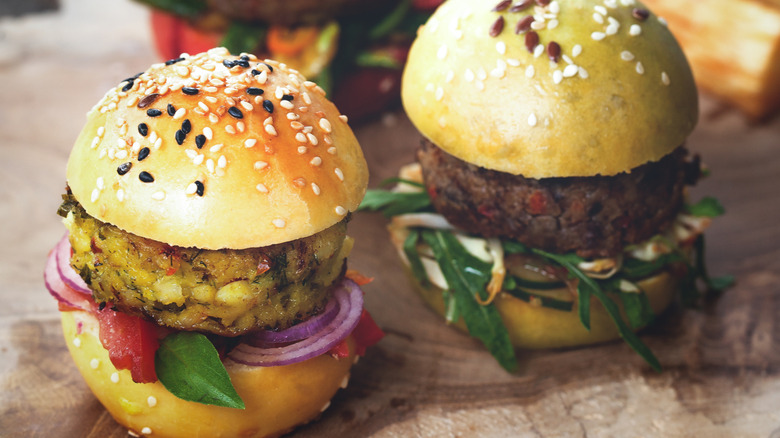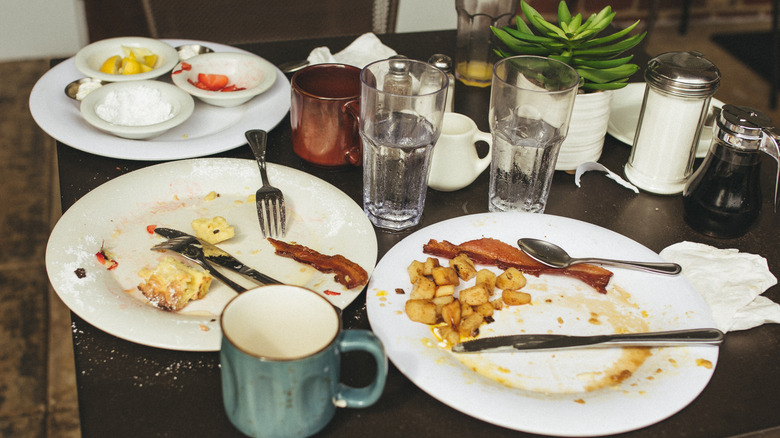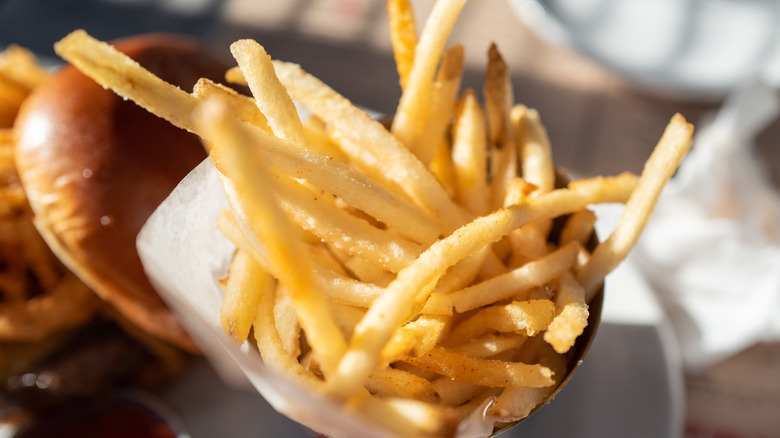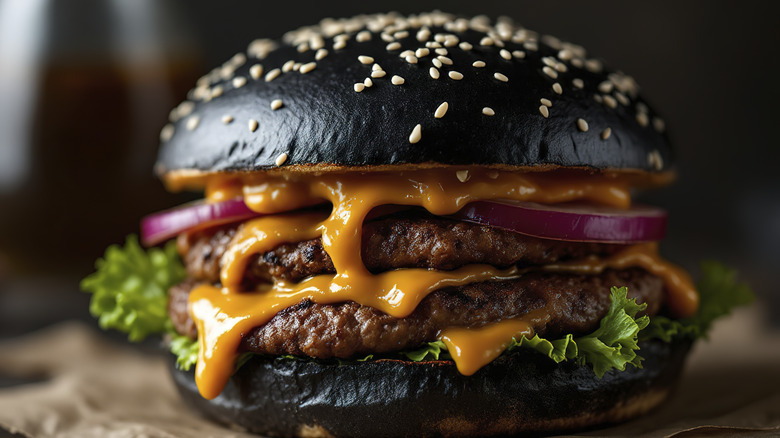10 Burger Red Flags To Watch Out For In Restaurants
What doesn't go into a burger is almost as important as what does. We tapped two seasoned pros to share their biggest burger red flags to prove the point. From the subtle to the glaringly obvious, here are the signs that a restaurant might be missing the mark.
Mark Crane, Executive Chef at The Cosmopolitan of Las Vegas, has more than two decades of global culinary experience. From Michelin-starred kitchens in Europe to helming some of the Strip's most iconic dining destinations, he knows a thing or two about getting the details right. This summer, he's channeling that expertise into Naughty Patty's, The Cosmopolitan's bold new smash burger concept launching at Block 16.
Meanwhile, John Masterson, Culinary Director at Bad Daddy's Burger Bar, brings over 14 years of hands-on experience shaping the brand's flavor-forward, no-nonsense burger identity. Having worked his way up from front-of-house management to leading culinary innovation across multiple states, he's built a reputation for keeping the focus squarely on the meat.
For both chefs, it's all about honoring the guest's expectations, mastering the doneness (especially for gourmet builds), and above all letting the burger be the star. Here's what they never want to see on a burger menu.
The burger was obviously prepared carelessly
Despite what chefs and grill masters may tell you about thermometers and internal temperatures, avid burger fans can usually spot an iffy patty at first glance (and sniff). Take it from us, your eyes and nose will tell you a lot more about the meal to follow than you think. According to the neuroscience of expectations, our brains predict taste based on what we see and smell — so if it looks sketchy, it'll likely taste even worse. And our experts concur.
"The ratio between the patty, toppings, and bun must be just right," chef Mark Crane told us. "Every component should play its part without overpowering the others." The outside of the burger should also have that enviable char (a sign of the Maillard reaction) wherein lies all the umami flavor.
If the meat smells like anything other than fresh, clean, and 'meaty', take a step back and assess your escape route. Unless it's been heavily sauced or seasoned, a burger patty that smells "off" usually is. Grinding beef exposes it to more air and, as a result, spoils faster. The pathogenic bacteria that proliferate can cause severe food poisoning and should be avoided. Other ways to tell if your rare burger is undercooked include a cold and mushy center or a patty that looks raw and red. A sticky, slimy texture is enough to tell you that this burger has only one destination — in the bin.
It tastes weird from the first bite
Sometimes the real disappointment hits only after the first bite. Maybe it's dry, maybe it's spongy, maybe it just tastes off? Chef Crane agrees. "Dry, overcooked or under-seasoned patties are the most immediate red flags," he said. Here's where seasoning comes in (and herein lies the big debate). Does one season before, during, or after grilling?
The expert opinion is that ground beef should remain unsalted until after shaping and just before adding on to the grill. The reason for this is that salt affects the very protein structure of meat, drawing out moisture, and affecting the ultimate texture. A chewy, dense burger can be attributed to how much it has been handled before being plonked on the grill. Mixing too much can lead to a dense, unpleasant texture and mouthfeel (which isn't just another way of saying taste).
"Raw beef is full of water and fat, and when cooked right, it should almost melt on your tongue," John Masterson explained. "Lower quality cuts will lack a lot of the rich fat that transports flavors over the palate, while poorly handled patties will dry out quickly and have a tough and chewy texture." If your burger patty has other stuff inside, besides salt and pepper — we're talking ingredients like onions, chilis, and bread crumbs — it's not the pure burger patty one desires. By their very presence, it indicates overworking, and therefore a breakdown of that perfect ideal texture. Red flags a-go!
The bun is a mess
The carrier matters just as much, doesn't it? Fast food chains have strict specifications when it comes to the bread they use. Uniformity of volume, texture, color, and taste is non-negotiable. Most use buns with high sugar and fat content for that signature color and soft chew. The shape should also be just big enough to snugly fit the patty within.
But that's the fast food outlets. What about the wave of gourmet burger joints offering vegan varieties and gluten-free options? What about the new breed of colored buns — charcoal, green, red? Are these signs of a culinary apocalypse or more than just made-for-Instagram gimmicks? The big question is, can you tell if a burger's going to be good just by the bun? "First impressions matter — the look of the bun sets the stage," said chef Crane. "But taste and structure are just as important. A great bun should complement the patty without overwhelming it. If the bread is too bulky, bland, or falls apart mid-bite, it compromises the entire experience. Again, balance is everything." This is why Anthony Bourdain famously hated brioche burger buns, because they disintegrate easily.
John Masterson believes that the bun "should be industrial enough to hold up to a thick burger patty, yet soft enough to meld into the background behind all the other flavor profiles." If your burger bun is too soft, crumbly, or not sturdy enough to hold up its tower of ingredients within, it's a no. The bread shouldn't overwhelm the burger patty, either.
The restaurant won't say where the beef is from
Today's diners care just as much about where their food comes from as how it tastes. So, restaurants better be ready with answers. Chef Crane understands. "It's increasingly important," he said. "Diners want to connect with what they're eating, and storytelling through food helps build that trust." Transparency isn't negotiable anymore. Customers have a right to know where their meat comes from, and how it was raised. Dining out is no longer just about ingredients, but also about ethics, sustainability, and sourcing.
If you're a restaurant serious about doing better, sourcing matters. Sure, responsibly produced ingredients are often more expensive. But the higher cost also reflects stricter regulations and better practices, resulting in food that is better for everyone involved, even before it reaches the table. There's also the matter of fluctuating beef prices due to global supply chains. This depends on various factors such as weather, demand, logistics, and political decisions that are far outside a restaurant's control. But using local suppliers helps mitigate that. "I think it's a fantastic inquiry to want to know where your food comes from, said John Masterson. "If you are doing things right, there is nothing to hide."
When your favorite burger place makes these choices, it shows. It means they're thinking about impact far beyond just flipping patties. Even chains like McDonald's are raising the bar, publishing sourcing and sustainability efforts online. That kind of transparency isn't just for optics, but what today's diner is looking for.
The restaurant is sneakily cutting corners
You're not imagining it — burgers are getting smaller. And we are not just talking small plates at fancy bars. Even your regular burger joint or favorite fast food chain seems to be shrinking portions and raising prices. Our experts agree that cutting corners is not the answer. According to John Masterson, "There is a fine line most concepts have to walk between quality and cost. I believe people taste the difference and are willing to pay a little more for something made fresh, made right, and that tastes great."
Sure, restaurants are feeling the squeeze. Rising costs, supply chain chaos, and the quest for profits in an increasingly unsustainable industry. But downsizing buns and patties in stealth mode isn't the way to win hearts.
So what are the signs that a restaurant may be cutting corners? "Start with the basics," advised chef Crane. "Is the burger properly seared with a good crust or grill marks? Is it well-seasoned? Are the buns toasted? Are spreads or sauces evenly applied? Look at the toppings — fresh, crisp lettuce and properly cut tomatoes are telltale signs. If those basics are off, there are likely deeper issues in the kitchen." That said, value burgers aren't necessarily a red flag. Not everyone can afford a dry-aged, grass-fed patty, and there's space on the table for affordable meat. But transparency matters. If you're going cheap, own it.
Staff that are indifferent
Can bad service signal other (shoddy) things to come? We asked our experts, and this is what they had to share. "A well-trained, motivated team creates a smoother kitchen flow and better guest experience," explained chef Crane. "When staff are knowledgeable about the menu, it minimizes mistakes and miscommunication. The guest doesn't just taste the food, they feel the energy of the operation, too. When morale is low or service is disjointed, it shows up on the plate and in the overall experience."
Unsurprisingly, John Masterson agrees: "The dining experience is just as much about how you feel while you eat, as is the food you are consuming. An enthusiastic staff who celebrates the culinary cuisine offerings to the guests sets the 'proverbial table' for the guest's emotions."
So, what do you do if you've experienced subpar service? Speak to the manager? Rush home to pen that scathing review? Warn friends and family? What's the most effective solution and one that gets results? First off, adjust your expectations. You can't walk into a Burger King or White Castle expecting five-star hospitality. That said, you can and should expect clean, consistent food and fast service. On the flip side, at a bistro or gourmet burger bar, you're absolutely within your rights to demand a certain level of attentiveness and care.
A messy dining room
There are some signs that scream 'stay away' – and they're not just about what's on the plate. "Cleanliness is the first indicator, both in the facility and among staff," said chef Crane. "If that's lacking, it's often just the tip of the iceberg." Cross-contamination at salad bars, servers not using gloves, handling food and then credit cards, or using the same cloth to wipe tables and trays, are all major red flags. Dirty floors, sticky restaurant menus, cloudy glassware, and half-used condiment packets left out? All signs of poor restaurant hygiene and sloppy management.
Also, trust your nose. Smells of garbage, grease traps, stale oil, or even overpowering bleach are warning signs. A strong fryer smell from the street? That usually means it hasn't been cleaned in a while. Bathrooms, too, are a hygiene litmus test. A lack of soap? That's a deal-breaker. When in doubt, check your local health inspection reports online.
Even a quick peek into the kitchen can reveal a lot. "When you see kitchen staff hanging out in the dining room or around the bar," said John Masterson. "When people move out of their work area it's usually a sign that structure and leadership is lacking. Think of this way, if the guy who is supposed to be cooking your fries is hanging around the waitresses instead, what else is likely amiss behind the kitchen door? Food First Focus."
A poorly cooked side of fries
Yes, we're judging, and so should you. You can tell a lot about a burger joint by the fries it serves. "Fries are a universal benchmark," said chef Crane. "They should be hot, crispy, and seasoned well. If they show up soggy, stale, or lukewarm, it suggests the kitchen isn't prioritizing execution or freshness."
So what makes restaurant fries so much better than your homemade attempt? It's all in the method. Most places use a two-step process: blanching and then frying. This double-cook approach gives fries that delicious crispiness and a crunch that still holds up even after a few bites of your burger. It's why McDonald's fries are so delicious. (Spoiler: They're coated in dextrose, a form of sugar, which helps with color and flavor.)
And timing matters, too. "Temperature is another clue," advised Crane. "If your burger or fries arrive lukewarm, that raises questions about holding practices or prep timing." According to John Masterson, "They must be hand cut fries, served hot, crispy, and seasoned very well. Frozen fries taste fine and have their place in fast food and fast casual, but are representative of the ultimate shortcut when it comes to sides."
The menu is filled with trendy burgers
Like everything else these days, there are food trends that go viral for no other reason than that they photograph or film well. Burgers are no different. Many chefs are using them as a blank page and letting their freak flags fly. But our experts have very definite opinions on some trends.
For John Masterson, it's truffle oil: "It needs to be taken behind the barn and shot. It's overpowering and certainly does not belong on everything. I'm almost at the point where I believe it may not belong on anything. Overused." Whereas for Chef Crane, there's "a time and place for everything, but I think all the different color buns can be overrated — charcoal (black), saffron (yellow), and other various colors that you may see in buns."
And let us interject here, trending does not mean just gussying up. We are all for classic flavors getting an upgrade. You want bacon in your burger, we say smoked bacon slaps. You need onions, why not caramelize instead of only frying? Flavored mayos work a treat, and pickling and ferments can only make things more funky and umami. Want to try a trending smash burger at home? Go for it. Experiment with what makes you happy, but stay close to the classic pillars of a good burger, and you won't go wrong.
Reviews that are overwhelmingly negative (and sometimes too positive)
What was supposed to be a helpful tool for honest feedback overnight became a battleground, where everyone is an expert — and a highly critical one at that. Unfortunately, this has led to hard work often going unnoticed amidst all the noise. So, are online reviews worth paying attention to? Well, certain reviews are, for example, those that mention serious issues like food safety, cleanliness, or consistently poor service. "Reviews can be helpful, but context is key," said chef Crane. "One-off opinions are less telling than patterns. If you see consistent complaints about cleanliness or undercooked food, that's worth noting. Photos can also offer honest visual cues about portion sizes, presentation, or messiness that words alone might miss."
Conversely, beware of places with only perfect, five-star reviews and no criticism. Even the best restaurants have off days, and it's easy to buy fake glowing reviews (just like followers on social media). The most helpful reviews offer specific, practical details like where to park, which dishes to avoid, or insider tips on hidden menu items. These insights come from real diners, not hype.
"I think most reviews are reasonably accurate, but you have to recognize most people are self-centered," said John Masterson. "If a reviewer is fired up about a poor experience, or fawns excessively over a fantastic one, there is likely exaggeration in both. Lastly, if you do read reviews, read A LOT of them as small sample sizes may lead to you missing out on an incredible dish."
